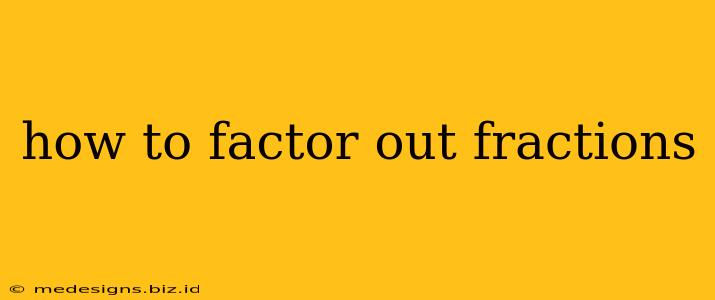Factoring out fractions might seem daunting at first, but with a clear understanding of the process, it becomes much simpler. This guide breaks down how to factor out fractions, providing clear examples and tips to help you master this essential algebra skill.
Understanding the Basics of Factoring
Before diving into fractions, let's refresh our understanding of factoring. Factoring is the process of finding what numbers or expressions multiply together to produce a given expression. For example, factoring the expression 6x + 12 involves finding the greatest common factor (GCF) of both terms, which is 6. We can then rewrite the expression as 6(x + 2).
Factoring Out Fractions: The Method
When factoring out a fraction, we're essentially looking for a common fractional factor among the terms in an expression. This often involves finding the least common denominator (LCD) and then simplifying. Here's a step-by-step guide:
Step 1: Identify the Common Fractional Factor
Examine the terms in your expression. Look for a fraction that divides evenly into all the terms. This might involve simplifying fractions within the expression first.
Step 2: Find the Least Common Denominator (LCD)
If your expression contains fractions with different denominators, find their LCD. This is the smallest number that is a multiple of all the denominators.
Step 3: Rewrite the Expression with the LCD
Rewrite each term in the expression using the LCD as the denominator. This step will make it easier to identify the common fractional factor.
Step 4: Factor Out the Common Fraction
Once all terms have a common denominator, look for the greatest common factor (GCF) which can be a fraction. Factor this GCF out of the expression, just as you would with whole numbers.
Step 5: Simplify (If Necessary)
After factoring, simplify the expression if possible. Check to ensure the factored expression is equivalent to the original.
Examples of Factoring Out Fractions
Let's illustrate this process with some examples:
Example 1: Simple Fraction Factoring
Factor the expression: (1/2)x + (1/2)y
- Step 1: The common fractional factor is 1/2.
- Step 2: No need to find an LCD as both fractions already share the same denominator.
- Step 3: Expression already has a common denominator.
- Step 4: Factor out (1/2): (1/2)(x + y)
- Step 5: No further simplification needed.
Example 2: Factoring with Different Denominators
Factor the expression: (2/3)a + (4/9)b
- Step 1: The common factor isn't immediately obvious.
- Step 2: The LCD of 3 and 9 is 9.
- Step 3: Rewrite the expression using the LCD: (6/9)a + (4/9)b
- Step 4: The greatest common factor is (2/9). Factoring this out: (2/9)(3a + 2b)
- Step 5: The expression is simplified.
Example 3: More Complex Expression
Factor the expression: (1/4)x² - (3/8)x + (1/2)
- Step 1: Notice that all fractions can be expressed with a denominator of 8.
- Step 2: The LCD is 8.
- Step 3: Rewrite with the LCD: (2/8)x² - (3/8)x + (4/8)
- Step 4: The greatest common factor is (1/8). Factoring this out: (1/8)(2x² - 3x + 4)
- Step 5: The expression is simplified.
Tips for Success
- Practice Regularly: The more you practice, the more comfortable you'll become with factoring out fractions.
- Break Down Complex Problems: If you're dealing with a complex expression, break it down into smaller, more manageable parts.
- Check Your Work: Always check your answer by expanding the factored expression to ensure it's equivalent to the original.
Mastering factoring out fractions is a crucial skill in algebra and beyond. By following these steps and practicing regularly, you can confidently tackle even the most challenging problems. Remember to always double-check your work for accuracy!
